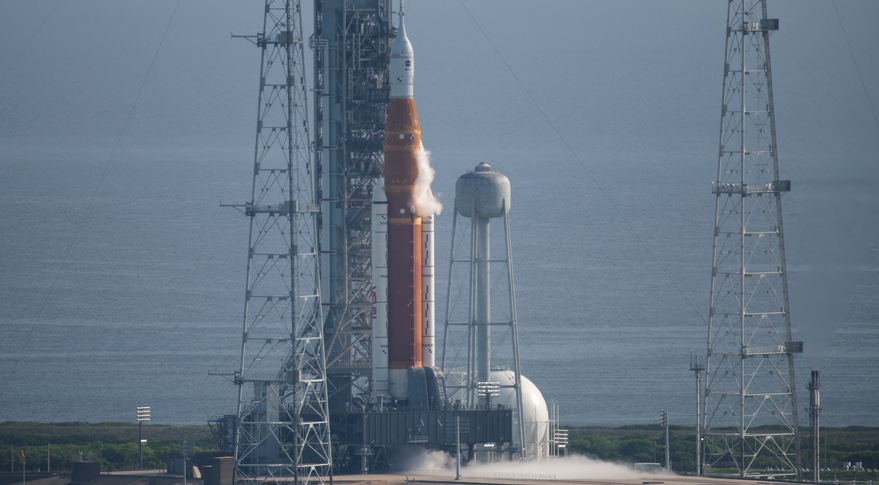WASHINGTON — NASA is laying the groundwork for another attempt to launch the Space Launch System on the Artemis 1 mission late this month, pending both repairs to leaking liquid hydrogen lines and negotiations with the Eastern Range.
During a Sept. 8 briefing, Jim Free, NASA associate administrator for exploration systems development, said the agency had requested launch dates of Sept. 23 and 27 for the Artemis 1 mission after technical problems scrubbed two earlier launch attempts Aug. 29 and Sept. 3.
The revised dates, he said, reflect upcoming work to remove and replace seals on two liquid hydrogen lines that connect to the SLS core stage and then perform a tanking test at Launch Complex 39B to confirm that the repairs eliminated leaks seen during the two earlier launch attempts. They also avoid planned use of the Deep Space Network, needed for communications with the Orion spacecraft, for the impact of NASA’s DART spacecraft with a moon orbiting the asteroid Didymos on Sept. 26.
That schedule depends first on completing work on the liquid hydrogen lines. Mike Bolger, NASA Exploration Ground Systems program manager, said crews were at the pad replacing the seal on the quick-disconnect fitting for one liquid hydrogen line, 20 centimeters in diameter, as well as a separate line 10 centimeters in diameter, that run from ground systems to the core stage of the SLS. He said both seals could be replaced by the end of the day if weather does not interfere with work on the pad.
Once the seals are replaced and the lines reconnected, NASA will begin preparations for a tanking test, tentatively scheduled for Sept. 17. In that test, the agency will fill both the core stage and the upper stage of the SLS with liquid hydrogen and liquid oxygen to verify the performance of the seals.
While the rocket will be fully loaded with fuel, NASA does not plan to conduct a formal wet dress rehearsal, as it did four times in April and June. “The purpose of this event is to prove to ourselves that the seals that we’ve replaced are good,” Bolger said. “We feel like the prior wet dresses that we’ve run have accomplished all of the requirements that we intended to capture.”
None of the previous wet dress rehearsals made it all the way to the planned cutoff time at approximately T-10 seconds, with the last one in June stopping 20 seconds earlier. “You might say it’s been piece-parted, if you will,” John Blevins, NASA SLS chief engineer, said of the previous rehearsals. A full tanking “is a really smart test to do risk mitigation going into the next launch attempt.”
Engineers are still investigating what caused the leak in the larger liquid hydrogen line that led to the Sept. 3 scrub. Bolger said there was evidence of a small “notch” on that seal that will be studied more closely. He added that was also not yet clear if an “inadvertent overpressurization” of that liquid hydrogen line during preparations to begin fueling caused the leak.
One change for future propellant loading of the core stage, he said, will be a “kinder and gentler” loading process that reduces the pressure and flow changes, based on how the tanking was done during Green Run tests of the core stage at the Stennis Space Center. “We noticed that when we temper the changes, we’re better able to manage those leaks.”
Even if the tanking test demonstrates the liquid hydrogen seals are now working, NASA cannot proceed with a launch without the approval of the Eastern Range. The flight termination system (FTS) on the core stage was certified only through the end of the most recent launch period, which ended Sept. 6. The U.S. Space Force’s Space Launch Delta 45, which runs the Eastern Range, would have to approve an extension of that certification without rolling the rocket back to the Vehicle Assembly Building to test the FTS batteries.
“We did submit our waiver package to them,” Free said. “We’ll look to hear from them on any clarifications that they need for us.” He didn’t specify a deadline for securing a waiver, other that it can’t come the day before the scheduled launch. “When we get closer to the tanking test, obviously we’ll have to make a decision after that if we don’t have a decision from the range.”
Free went to great lengths to praise the Eastern Range and its commander, Space Force Brig. Gen. Stephen Purdy, suggesting that comments he made after the Sept. 3 scrub about seeking a waiver were somehow misinterpreted by the range. “Gen. Purdy and his team have just been fantastic at listening to where we want to go and giving us their thoughts,” he said.
Blevins said that test data NASA had about the FTS batteries showed “considerable time” remaining on them. “The last three days have been constant contact” with the Eastern Range regarding the data they need to evaluate a waiver.
Should NASA get approval to proceed with a launch later this month, the Sept. 23 launch window opens at 6:47 a.m. Eastern and lasts for two hours, and would result in a “short-class” mission that would end with an Orion splashdown Oct. 18. The Sept. 27 launch window opens at 11:37 a.m. Eastern and runs for 70 minutes, and would allow for a “long-class” mission ending Nov. 5.
